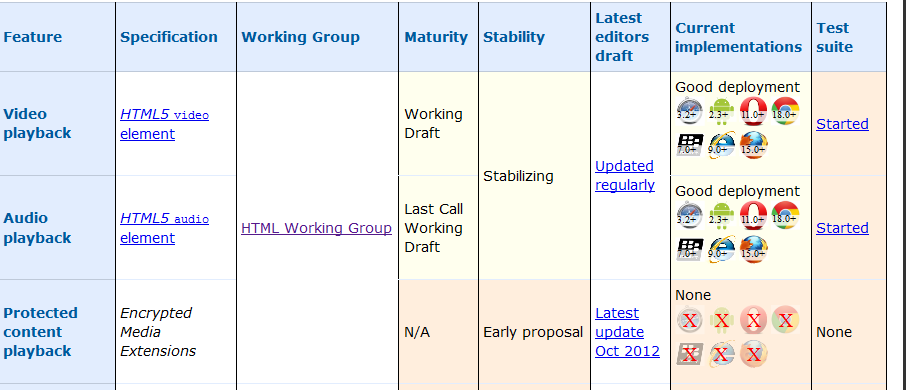Directions for using Slide Show
- Works across browsers
- Advance to next slide with mouse click, space bar or swipe left
- Move forward/backward between slides with Cursor Left,
Cursor Right, Pg Up and Pg Dn
keys, or swipe left or right
- Home key for first slide, End
key for last slide
- The "C" key for an automatically generated
table of contents, or click on "contents" on the toolbar or
swipe up or down
- Function F11 to go full screen and back
- The "F" key toggles the display of the footer
- The "A" key toggles display of current vs all
slides
- Font sizes automatically adapt to browser window size
- use S and B keys for
manual control (or < and >, or the - and
+ keys on the number pad
- Use CSS to set a relative font size on a given slide to make
the content bigger or smaller than on other slides
- Switching off JavaScript reveals all slides
Copyright © 2005-2013 W3C ®
(MIT, ERCIM,
Keio), All Rights
Reserved.
The Promise of Mobile Accessibility
- portable
- personalized with your data and settings (BYOD)
- free or relatively inexpensive apps
- built-in cameras, accelerometers, gps, etc
- mainstream demand for accessibility features
Mobile is more than just phones...
- phones
- tablets
- TV Remotes
- videogame controllers
- devices we don't even imagine yet
What is W3C/WAI?
WAI develops strategies, guidelines, resources to make the Web accessible:
- Accessibility support in W3C technologies
- Guidelines for implementing accessibility
- Methods for evaluating accessibility
- Developing resources for education and outreach
- Coordinating with Research and Development
- Standards Harmonization
How do W3C & WAI standards support Mobile Accessibility
Existing accessibility guidelines and standards provide extensive guidance on mobile accessibility
- WCAG 2.0 was designed to be forward-compatible, and is proving to be so
- UAAG 2.0 includes mobile in guidelines for user agent and user interface accessibility
- IndieUI Events is new work toward web apps independent of device or input method
- Many additional W3C and WAI resources that support mobile accessibility
- WAI/mobile/ — central document with links to WAI & W3C resources that apply to mobile
WAI/mobile/
- brings together many different W3C resources for mobile and accessibility
- today there are links to the resources
- in the future, we want to make it easier to use
- in process (there are opportunities to sponsor WAI work)
W3C and WAI Resources for Mobile
Business Case for Mobile Accessibility in Your Organization
Mobile and Accessibility share some similar barriers
Cost savings in developing for both, especially early in the project, because once your website is ready for mobile it is most of the way toward being accessible.
Mobile Accessibility Resources
Mobile Resources
How WCAG 2.0 Applies to Mobile
WCAG at a Glance
WCAG 2.0 was designed to be flexible. It's Principles can be applied to different types of web sites, different technologies and different devices.
WCAG 2.0 Principles
- Perceivable
- Operable
- Understandable
- Robust
Examples of WCAG 2.0 Applied to Mobile
WCAG 2.0
While all the guidelines of WCAG 2.0 apply to mobile, these are some of the most relevant:
- labels for buttons and control (1.1.1, 4.1.2) - Voiceover, Talkback or other text to speech
- sufficient contrast (1.4.3, 1.4.6)
- mobile's reverse video is not desktop high contrast, also needed for outdoor brightness
- captions, transcripts and sign language interpretation (1.1.1, 1.2.2, 1.2.4,1.2.6) - media players
- audio description (1.2.3, 5, 7) - media players
- adaptable layout (1.3) - one handed use
- focus visible (2.4.7) — intended for keyboard, but also needed by touch users
User Agent Accessibility Guidelines Mobile Examples
User Agent Accessibility Guidelines 2.0
Implementing UAAG 2.0 - latest editors' draft with mobile examples
As the web is increasingly becoming the platform for interoperable applications, the need for accessibility guidelines for the user interface is also increasing.
-
Setting preferences for text display (1.4.1) Ben chooses the larger text for font size in the mobile settings dialog box so that it is easier to read with his low vision. Note: This requires that the mobile OS reveals the system font setting to the app developer, which is not yet available on all mobile platforms.
- Open on Request (1.8.9) Ray's mobile device automatically opens location links and calendar dates found on web pages in native apps available on the device. When he returns to the browser, focus on the original link is maintained so he knows his location, even though he cannot see the page.
- Multimodal keyboard operation (2.1.1) Karen cannot easily use the onscreen keyboard to navigate Web pages on her mobile phone because of muscle weakness. Instead, she uses gestures to move between elements on the page. As focus moves from one element to another, there is a visble focus indicator.
- Move viewport to focus (1.8.2) Lee typically views web content on her mobile phone at a high level of zoom, frequently positioning elements outside the viewport. When moving between focusable elements, the viewport automatically scrolls to the element currently in focus.
- Direct Navigation to Important Elements (2.3.1) Mary uses speech input with a mouseless browsing plug-in for her browser and smartphone since her repetitive strain injury. The plug-in overlays each link with a number that can then be used to directly select it (e.g. by speaking the command "link 12"). This prevents Mary from having to say "tab" numerous times to select a link.
- Present Direct Commands from Rendered Content (2.3.2) When reading email on her tablet, Mary touches a control which opens a toolbar with a setting to display the accesskeys and other direct commands that the author created. She sees that a 3-finger swipe will delete the current email.
- Document Accessibility Features (3.3.2) Neta relies on gestures and shortcuts to complete tasks because of her repetitive strain injury. Using a specialized command, she can pull up a list of all the gestures and commands available with descriptions on how they function.
More UAAG 2.0 Examples
Some examples are not currently supported on current mobile technology:
Events for User Interface Independence
Events for User Interface Independence (IndieUI) First Public Working Draft
specifies a layer between device input abilities and what the user wants to do, such as
- scrolling a view
- canceling an action
- adding a value to a widget
- selecting a range, etc
so that the device can infer what action the user wants — no matter what the modality (keyboard, mouse, touch, gesture, speech) or the raw input (e.g. a 3 finger swipe custom gesture) — and send the appropriate event to the web application.
Please send comments on this Draft by 22 February 2013.
HTML5 Accessibility
HTML5 is not finalized, but is becoming a stable draft. Some improvements for accessibility are:
- new markup helpful for navigation <nav>, <article>, <aside>, <header>, <footer>, <section>
- improved error reporting in forms completion
- improved integration of WAI-ARIA to allow authors to
provide additional accessibility semantics when needed
HTML5 and web apps
- a single application can work cross platform - desktop, mobile, android, iOS, and others
- don't require an app store
- increasing use of APIs for communicating with the device (camera, GPS, accelerometer, etc)
W3C Report on Standards for Web Applications on Mobile
Standards for Web Applications on Mobile: current state and roadmap
Report sections of potential interest to AT developers:
- Graphics — Web Open Font Format, Fullscreen API
- Multimedia — analysis of audio, video and images.
- Device Adaptation — Device Description Repository, Media Capture (cameras), CSS Media Queries and Device Adaptation (identifying the device capabilities and adapting the web app to the device)
- Forms — Date & time, pattern, placeholder, datalist and new type= for improved error reporting
- User interactions — Accessibility, touch, vibration, speech input, and web notifications
- Data storage
- Personal Information Management — Contacts API and Calendar API
- Sensors and hardware integration — APIs for Geolocation, sensors for ambient light, proximity and humidity; device orientation and acceleration, near-field communications and USB & bluetooth.
- Network
-
Communication_and_Discovery
- Packaging
- Performance & Optimization
W3C Report on Standards for Web Applications on Mobile
Each section of the report contains a written description of the standards and the changes since the last report. Each section contains a chart with the spec, working group link, maturity, stability, latest editors draft, current implementations (by major browsers), and test suite.

What's Next?
Web Accessibility Initiative's work relies on public participation to obtain the quality of results we all want.
- Comment on specifications
- Subscribe to email lists
- Join community groups or working groups
- Your organization can become a W3C member
- Your organization can become a WAI sponsor
- The Assistive Technology community is particularly critical for mobile web accessibility, please come join us in this effort.
Participating In WAI -> w3.org/WAI/participation















